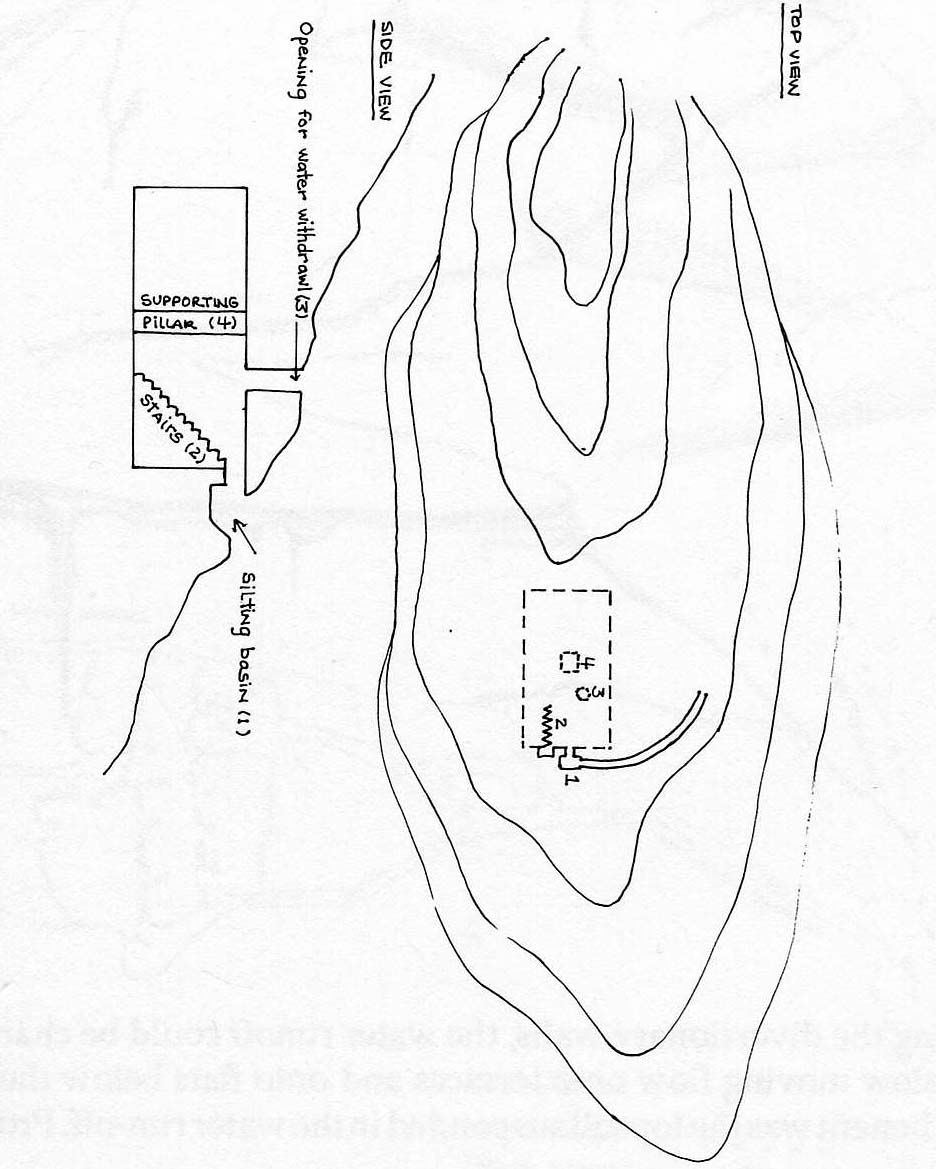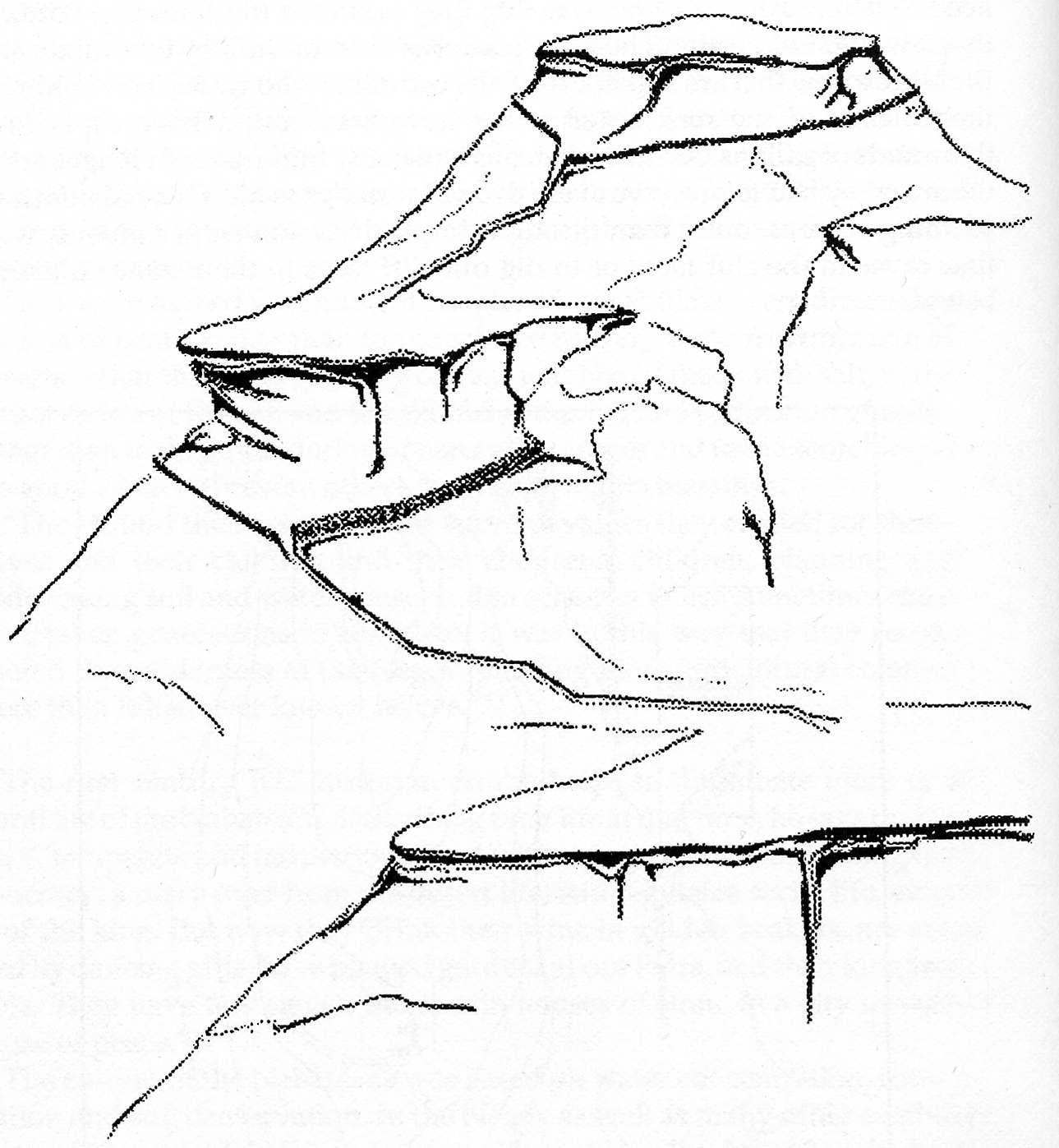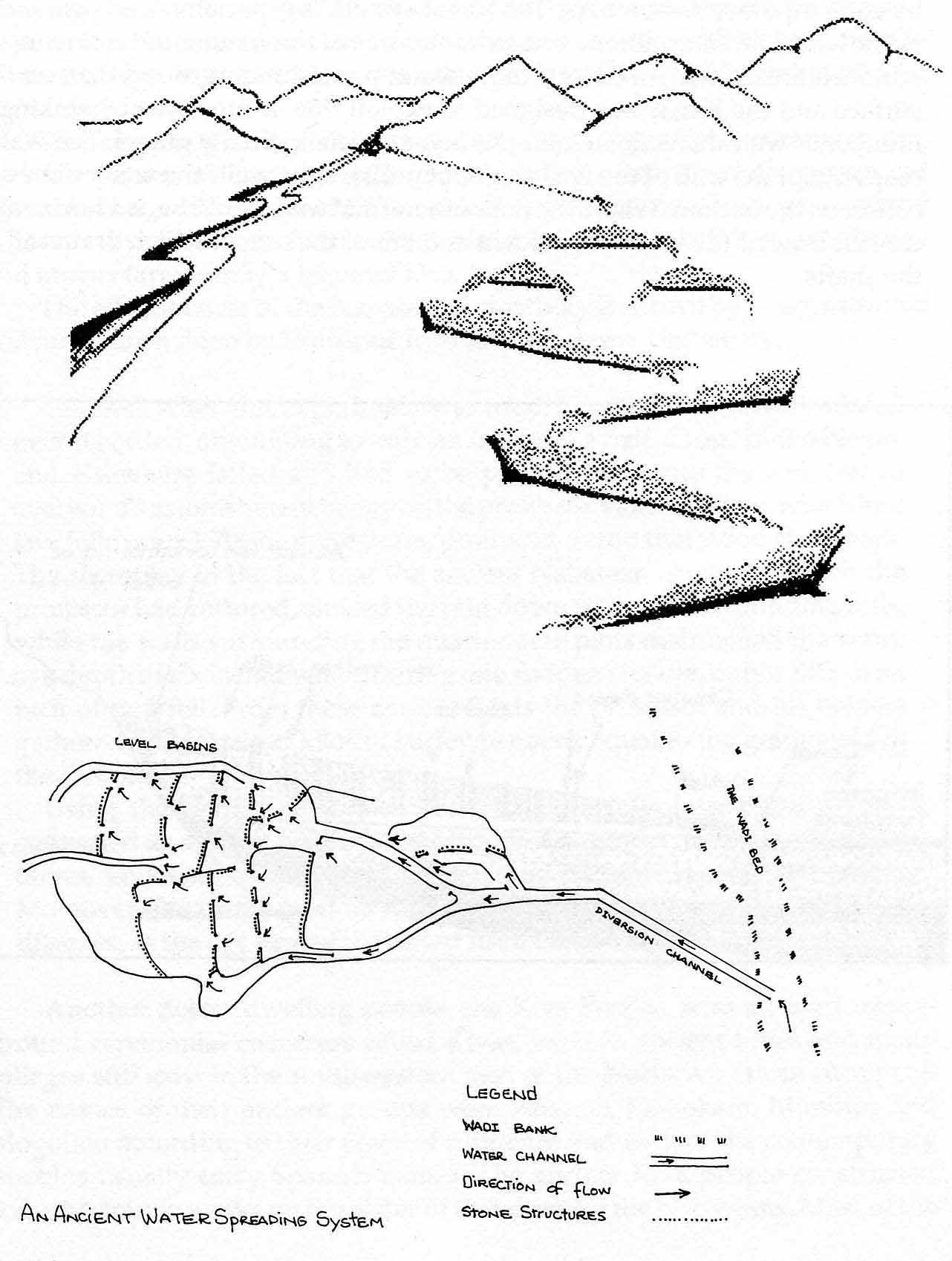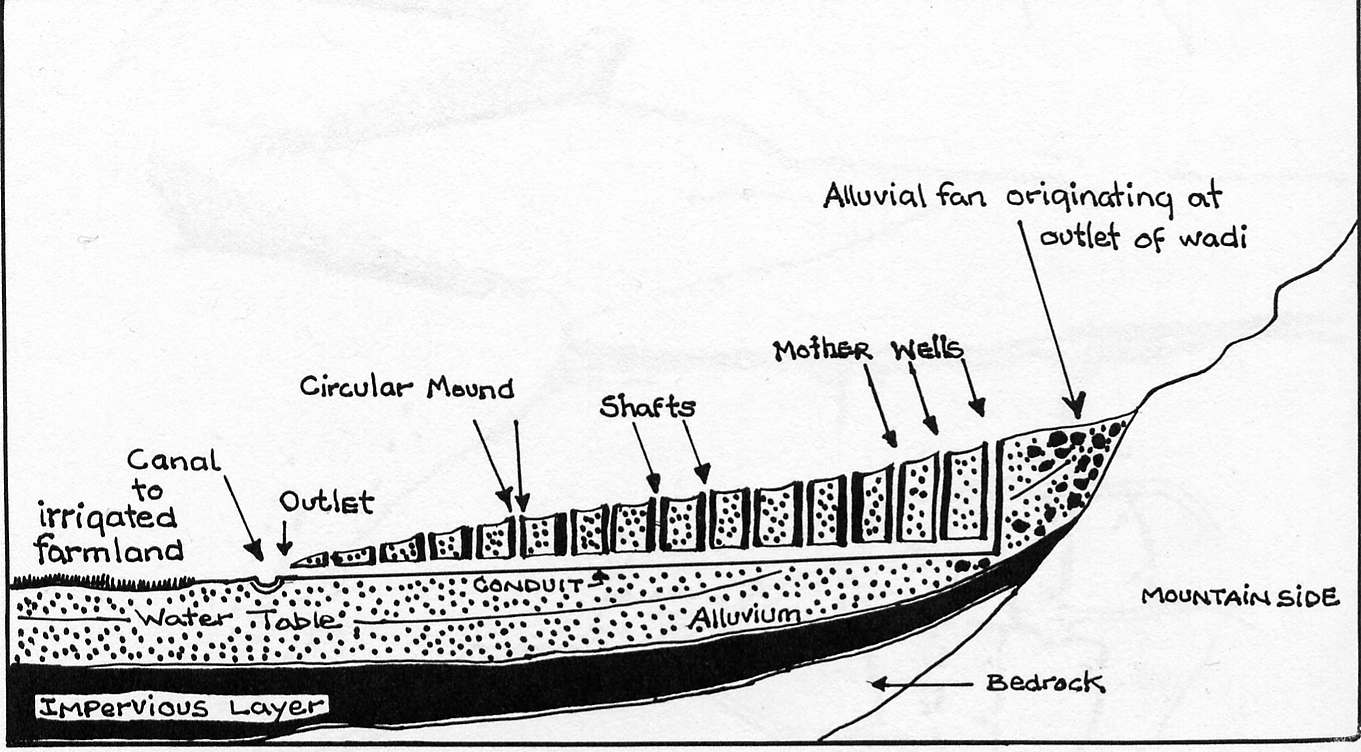

PERMANENT DESERT CULTURE
The model, the example of "living in balance with nature" that will be explored, is a watershed that exists in a semi-arid environment in the Southwestern United States. Because this area exists in that climate, it will be useful to survey the different strategies that humans have used to adapt to these regions. While this model applies to the near desert areas, it is suggested that a similar analysis be applied to any area in which a community of people may want to establish.
The Forager Example 295
Adaptations to the desert environment have been sedentary, nomadic and variations between the two. The Bushmen people of Southern Africa are a very ancient race of people that populated the cone of Southern Africa until the very recent arrival of the negroid, Bantu people and others. These people who are as physically different from the negroid peoples as the caucasians are from the eskimos, have been eliminated in most of their previous habitat and only survive in the severe environment of the central deserts of the cone where the non-adapted could not, until recently, enter- the Kalahari.
The Bushmen people are probably equal to the northern Eskimos in the incredible balance that they maintain with the life around them. For eight to ten months of each year they have no obvious source of water. Their liquid comes from plants and animals. Their water diet is so meager that every possible drop of liquid is squeezed from each animal that they kill and saved for consumption. Yet, researchers and visitors that know the Bushmen people say that they are happy, kind, cooperative, and well adjusted to their environment.
Anthropologist George Silberbauer lived with a group of Bushmen clans in one part of the Kalahari Desert. The group that Silberbauer lived with and studied he named the G/wi for recognition in the English language. The G/wi he states, "have water for only six to eight weeks in most years."1 The balance that the G/wi have reached with their environment is so fine, Silberbauer notes, that they often exist on the edge of heatstroke during the hot, dry seasons yet he never witnessed heatstroke. He states:
"Many G/wi, by their lassitude, malaise, and atypical irritability manifest what appears to be the prodromal signs of heatstroke, which, although they do not develop into stroke episodes, indicate how slender the margin of survival sometimes becomes under these conditions."2
The earth in the G/wi homeland is predominantly covered by grasses, forbs, brush (especially thorn bushes), and some trees. The people migrate throughout their land and attempt to camp near waterholes or sources of moisture. Edible plants make up the bulk of the G/wi diet; from 75 to 100%, according to Silberbauer. He states that there are 30 odd species that are the main subsistence for the group and he further notes that there are plant species that are consumed only for their moisture value rather than for their limited value as food. The G/wi do eat meat of course, when they can. Silberbauer lists 20 species that are used ranging from giraffe, down through a number of antelope types to other species such as porcupine, warthog, rabbits, jackals, rodents, birds, tortoises, snakes and frogs. He also indicates a substantial diet of invertebrates. Silberbauer calculates the annual meat consumption at 93.l4 kg. per person. Other researchers have noted that the caloric and protein value of food consumption of Bushmen peoples generally compares with that of Europeans.
As various students of the Bushmen peoples describe them, they have few possessions other than functional tools and utensils. Researchers also comment on their somewhat mystic profundity. One anthropologist who has studied other bands of Bushmen in another (and slightly wetter) area of the Kalahari says that they identified 200 plant species and 220 animal species for him and probably most were used for food, medicine or materials.3 This encyclopedic knowledge of the life around them and the sensing of its pulsations and movements begins to take on a mysterious aura to a person who has not lived life with the natural world. For example, the arrow point poison that is used by the G/wi comes from a larva of a particular beetle. This beetle larva that exists in cocoons some 20 to 25 cm. under the ground, are only found under a certain kind of large bush, the corkwood. The poison is only active when it enters the bloodstream and can be ingested without harm. This makes it an ideal poison for hunting arrows. How the G/wi learned of the larva and learned to use the poison is a mystery which indicates the profound sense that they have of the life around them.
The life cycle of the Central Kalahari is a two phase cycle of summer rains and winter dryness. During the rainy season the seed inventory that has been dispersed over the desert floor, germinates and the plant life flourishes, animals of all kinds gestate and lay eggs and water holes fill. At this time the tsama melons, a basic staple which provide food and moisture for the G/wi, proliferate. At this season, Silberbauer estimates that there were 29 usable species of plants available. It is during this time that the families and bands come together because the concentration of people can be supported in one area. At this wet season time of May in the southern hemisphere, the grouped people travelled only a few miles foraging for food. The people have a migration pattern that fits the season, the moisture and therefore the immediate food availability. As the season begins to dry the people disperse. The concentrated group breaks up and the bands go to different water holes. Hunting involves considerable travel on the part of the men. When bow and arrow hunting, the men go on several days trek. In this case they jerk the meat, that is they sliver it into thin strips and sun dry it. In this way it can be conveniently carried back to camp, although any moisture derived from the animal must be consumed on the spot. The people do use snares to catch smaller animals but this is only done near camp where the snares can be visited several times each day, because, as the observer notes, N!adima, their word for the creator, would be offended if they caused, "One of his creatures unnecessary suffering." Clubs, used in beating and throwing are also used to harvest small game.
The people occasionally rob the lions of their kills by rushing up to the lions and scaring them away. According to observer Silberbauer; " The trick lies in correctly judging the moment; if approached too early in its feed, the lion will attack, and if left too long, until it is sated and lazy, it will stand and defend its kill rather than run."4 An interesting sidelight is the complete sense of sharing and mutual aid in this culture. The anthropologist, Silberbauer, who came to the G/wi from another culture and pattern of conditioned perception, treats the question of private property at some length. In trying to get at this question in this Pleistocene culture, he was not very successful. He explains:
"I have equated ownership with exclusiveness of use or control of use. The concept of ownership is not highly developed among the central Kalahari G/wi and I found difficulty in discussing it with them....
Undisturbed, untouched, and unclaimed territorial assets are owned by N!adima but are subject to human ownership once the process of their exploitation has been initiated. For instance, when a man signifies his intention to hunt a particular animal, it is wrong for any other man to attempt to take the animal for himself unless and until the hunt is abandoned by the first claimant."5
Silberbauer says that among the G/wi only the plant food that is needed that day is collected for the household and this is shared equally by the household and elderly or invalid. When the good fortune of catching a large animal occurs, the meat is distributed between hunters, helpers and the camp at large. Anthropologist Richard B. Lee in his study, "!Kung Bushmen Subsistence: An Input-Output Analysis," states concerning the sharing of food, that hunters hunt individually or in pairs, but:
"Cooperation is clearly in evidence, however, in the consumption of food. Not only do families pool the day's production, but the entire camp-residents and visitors alike-shares equally in the total quantity of food available. The evening meal of any one family is made up of portions of food from the supplies of each of the other families resident. Foodstuffs are distributed raw or are prepared by the collector and then distributed. There is a constant flow of nuts, berries, roots and melons from one family fireplace to another until each person resident has received an equitable portion."6
Silberbauer notes interesting relationships between the life of the people and the life of the land. The human manuring around camps results in seed dispersion of useful plant populations in areas that are preferred camp sites for humans. He notes that the manure is worked into the ground along with the seeds by the cooperating dung beetles so that the seeds are nicely planted and ready for the next seasonal germination.
Silberbauer observed the G/wi burning grasses to promote the growth of the ground running vines of cucurbits. The grasses were burned off and then when the moisture came in, the burn spot was the first to green up. This green growth of grasses attracted the herbivores who ate it down severely (and in being there, made themselves available as food). The cucurbits then had the sun to maximize early growth, when in usual habit the cucurbit normally started its natural cycle of growth well after the grass. In the extremely dry time when animals and birds have migrated long distances away and others are in hibernation or relatively suspended animation, the G/wi also become withdrawn in a similar manner. By this time they have broken down into the smallest family units.
Even though it may seem to many that the G/wi endure hardship and in material terms are quite poor, they display a consciousness of their place in the universe, a spiritual sophistication and a human maturity far more developed than many other cultures. They are humble and careful not to take more than they need for their sustenance. They never shoot more than one game animal due to their consideration of N!adima who owns the world and consideration of the other beings who live with us on the earth. Silberbauer notes that the much valued ostrich eggs, which the G/wi find and use for food as well as valuable water containers, are each the equivalent of two dozen chicken eggs. Nonetheless, when the G/wi find an ostrich clutch, which may number ten to fifteen eggs, they only take two or three.
Silberbauer visited the G/wi in 1958-1966. He states that soon after, the long drought in the Kalahari broke. The herders, miners and others moved in to get what surpluses existed, hence the G/wi, like many other Bushmen peoples before them are no more. He says:
"...For better or worse, the close-knit, self-sufficient organization of band society, which is described in this book, and the completeness of the band member's control of their society are gone. The 'ethno-geographic present' is now the past."7
A Sedentary Example 299
The ancient Nabateans of the Negev Desert were a people who created an organic niche for themselves within the metabolism of the earth. Rather than just live in balance like most foragers, the Nabateans actively created an organic space for themselves over and above what the earth offered. They did this without damaging the other life or taking away from it. They created a new organ that further enhanced the life of the earth toward greater diversity, fertility and refinement.
The civilization of the Nabatu demonstrates what can be done by a creative group of people. The Nabatean civilization existed in the Negev and Sinai deserts for approximately two centuries and produced an amazing and exquisite culture in a land of as little as two to four inches rainfall per year. These people had no "resources" other than their creativity. They demonstrate that right now most of the deserts of the world could be successfully inhabited. This could not, of course, be done within the context of industrial civilization.
Little is known about the origins of the Nabateans. Scholars conclude, based on the existing evidence, that they were a tribe or group of tribes coming up out of Arabia into the Sinai-Negev area. Little is known either about the natural history of the Sinai-Negev desert. The interior desert has an average of four to eight inches of rainfall in the northern part of the Negev and this becomes less toward the south into the Sinai. The land forms and climatic systems are such that rainfall-vegetation regimes can change radically in only a few miles as one travels from the Mediterranean Sea, east into the desert. Efraim Orni and Dan Yaalon, in their survey of the soils of Israel, mention that the soil of the southern Negev is covered by "reg" soil which is a dark, flinty and gravelly desert pavement. Beneath this relatively impermeable surface is "a pale, loose, loamy layer up to one foot (30 cm.) thick."8
This fact would tend to indicate considerable vegetation at some time in prehistory. The Northern Negev in the Beersheba lowlands is a yellowish-brown loess, according to the authors, and is typical of desert fringes, being soil that is brought in from the inner desert regions by dust storms. Although many desert sections of the present Middle East were forested in ancient times, little is known about what the vegetation cover of the Sinai-Negev may have been. Though there is a long history of settlement in the Negev, it was usually also a very sparse population up to the time of the Nabateans.
Although scholars find no evidence of village life for the Nabateans earlier than the first century B.C., historians believe that they were in the region as nomadic tribes. There are indications that they were not a semitic people but were aboriginals displaced from Arabia by the present inhabitants.9
Nelson Glueck, probably the foremost scholar of this singular people, sums up his view of them in his study, Rivers In The Desert:A History of the Negev, by saying:
"Their rule prevailed for several centuries from Arabia to Syria and across the Negev to Sinai. They may be accounted one of the most remarkable peoples of history. Springing swiftly out of the desert of Arabia to a position of great power and affluence, they were thrust back by the Romans even more swiftly into the limbo whence they came. While their turn lasted, the Nabateans wrought greatly, developing almost overnight into builders of magnificent cities, which are unique in the history of the handiwork of man. They became tradesmen, farmers, engineers, architects and artists of outstanding excellence. The phenomenon of their appearance and disappearance between the first centuries B.C. and A.D. may be likened to the brilliance of a meteor flashing briefly across the skies to blazing extinction.10
They were indeed a wonderful people, whose abilities were directed to the arts of peace rather than to the science of war, to the fructification of deserts rather than to the sowing of their neighbors' fields with salt, to the conservation of the soil and the skillful gathering and utilization of water rather than to the squandering of natural resources and to the scorching of the good earth to prevent others from enjoying its blessings.
"They found their reward in the survival values they created for themselves and their children and their childrens' children, planning and undertaking soil and water conservation schemes which sometimes must have taken generations to complete. It was in this way that they reconquered the wilderness of the Negev, planting more agricultural colonies there than it had ever known before."11
The first century B.C. historian Strabo helps to illuminate more of the cultural life of the Nabateans. Describing their life at that time, he says that they were, " 'temperate and industrious,' and with stringent laws concerning thrift. Democracy, a carry-over from the desert life, still regulates social life, even to that of the king. But now they drink their wine in golden beakers, are entertained by dancing girls, have planted gardens about Petra, and their king wears purple. They have few slaves, but live in houses of stone in a city unwalled because of peace."12
The culture of the Nabateans was based on water concentration, containerization and soil conservation. In the Negev as well as many other semi-arid deserts of the world, rainfall comes only sporadically, but often in heavy torrents. If the area has tree cover and good vegetation cover of other varieties such as grass, the land is able to harmonize the cycles of moisture, by absorbing the water. If the land has been abused or if it is simply too dry to support much vegetative cover, the rain simply runs off in torrents to sink finally in the desert lowlands.
The Nabateans existed in a desert that was very arid and had little vegetative cover. Their strategy was not to try to build soil on the expanses of desert but to use the expanses for water catchment and then to concentrate the water runoff into areas that could be intensively worked to build the soil. Because much of the environment was rock and ground with an impermeable pavement surface, they were greatly aided in the water catchment effort and made full use of this fact.
One of their talents was the containerization of water. They often cut cisterns out of solid rock (as they cut their most important city, Petra out of rock). They also used plaster created from the burning of local limestone. Plaster enabled them to dig holes in the ground almost anywhere they might need a cistern. After the hole was dug they plastered the sides and bottom so that it would hold water. There are plastered cisterns built by the Nabateans in the Negev now that are still in use by the bedouins who water their herds from them. Some of the rock cisterns that have been found have capacities of thousands of gallons. As the Nabateans had many hundreds of villages around the area they had to preserve every drop of water possible. One ingenious way of filling cisterns, other than through simple diversion from canyons, was to find caves in the cliff faces or to dig out cliff faces in the manner illustrated below.

The Nabateans by the use of dams, terraces, diversionary wells, channels, aqueducts, cisterns and reservoirs, used whole watersheds as catchment areas. Their devices ordinarily went right to the tops of the valleys and canyons so that any sudden rush of water was tempered and utilized to its maximum. They used walls of rock several feet high that encircled mesa tops.

By using the diversionary walls, the water runoff could be channeled in a relatively slow moving flow onto terraces and onto flats below the mesa. An additional benefit was the topsoil suspended in the water run-off. Provided that the water wasn't cutting erosion strips, the silt that ran off would be the lighter material that had organic value in the farming areas.
After the water was concentrated it had to be spread onto the fields. Its velocity had to be checked so that it didn't dig out erosion paths in the fields. The Nabateans did this by having their fields on multiple levels. The Nabatean farmer could give some fields a small amount of water while others received more, thus making adjustment for different varieties of plants. This was done by having higher or lower spillways, thus impounding a pre-set level of water.

In the canyon bottoms a system of basins followed each other downhill. These were constructed so that as each basin filled, the excess water ran to fill the next basin. The spillways were constructed of tightly fitted rock that was set so that the water would not run out until there was six inches of water in the basin. This slowed the water enough to prevent erosion.
The Nabateans used wells when they could reach the water table. Artesian wells still remain in the Negev from the Nabatean days. In a few instances water bearing aquifers were located. These would be strata of sandstone or other porous material that was holding water. Workers dug horizontal tunnels into the hillside until they reached the water bearing strata. Another creative technique was a combination of water catchment and well. It is called a Kanat by contemporary researchers. The Kanat system is especially used just at the point where an intermittent stream comes out of the mountains and enters a flattened area. Often, in deserts more water travels underground than on the surface and the Kanat was designed to exploit this. It functions by sinking a number of well shafts down into this layer which is usually gravel. The water seeps out of the wall of the well shaft but unlike most wells the water does not collect on the bottom. Where the floor of a normal well would be, is a horizontal tunnel. Instead the water runs down and out of the tunnel which drains all of the shafts.

Daniel Hillel, in his study, Land, Water and Life In A Desert Environment, states that at the peak of the cultural manifestation of the Nabateans, there were many hundreds of farm units in the northern Negev; that "runoff farming encompassed practically all of the usable land in the northern Negev." Glueck states also that the Nabateans held "millions of gallons of water," in their cisterns and reservoirs, giving an idea of the extent of their works.13
The average wadi bottom planting according to Glueck was around twenty five acres. Hillel estimates the average runoff in the Negev to be from 10% to 15% of rain falling on the catchment basin and he puts the water requirements of winter crops in the Negev at about four inches of rain (or other water). From these calculations, Hillel states that the ratio of catchment basin to growing area must average 25:1. Other crops than standard field crops do better apparently. He does cite an experiment that he has done with almond trees in an area of eight to ten inches rainfall that grow well with a 3:1 catchment area to planted area.
Tree crops in the Negev are almonds, apricots, figs, olives, pomegranates, and date palms. Wheat is a winter crop and summer crops include grapes and cucurbits (i.e., melons, squash). The ancient Nabateans must have grown many of these crops. We know from written historical records that they grew barley and aracus (apparently a legume) also.
The effectiveness of the Nabateans' creativity is shown by a reconstituted Nabatean farm done by Professor Evanari of Hebrew University:
"In 1960, when this experiment was tried, Israel had the lowest rainfall ever recorded, amounting to only an inch and a half. Crops in the Negev and elsewhere failed and had to be plowed back into the soil, but to everyone's astonishment barley on the professor's ancient farm, which had lain fallow for 1,700 or more years, produced a crop that stood chest high. The secret lay in the fact that the ancient Nabatean channels, which the professor had restored, sluiced the rain down from the surrounding hills, while the walls surrounding the quarter-acre plots maintained the water at a depth of six inches when, during one sudden shower, only a fifth of an inch of rain fell. From these ancient fields the professor and his helpers gathered five hundred kilos of barley per acre, equal to the grain yield in the Dakotas.
Using the same principle of flood irrigation, Professor Evanari has converted an ancient wadi system into acres of grapes, apricots, almonds, olives, and such vegetables as asparagus, cucumbers, and artichokes. Moreover, the plants need no sprays to protect them from the usual plant diseases, as the dry heat of the desert itself bakes and sterilizes the soil."14
Another desert dwelling people, the Kiva People, who all used underground ceremonial chambers called Kivas, lived in ancient times and many villages still exist in the southwestern part of the North American continent. The names of their ancient groups were Anasazi, Hohokam, Mimbres and Mogollon according to their place of residence and each of the contemporary pueblos usually carry Spanish names. The ancient Kiva people constructed some hydraulic works on the order of that done by the Nabateans. Most of the land where the ancient Kiva People lived received between 10 and 20 inches of rain per year so they did not have to go to the extremes of the Nabateans in their engineering and design.
They did use terracing, channeling-off water catchment areas and dams in their agriculture, even though they were able to farm dry land to a greater extent without the water concentration devices. Probably the majority of effort was flood-plain agriculture. This is simply planting flood plains with flood water channelled on to it. They had additional techniques that the Nabateans are not known to have used. One of these techniques was to find sandstone cliffs with a spring at the base. This indicated that the sandstone was an aquifer holding water. The Kiva People constructed dams on the mesa top and the impounded water would sink into the aquifer rather than run over the side. This increased the spring flow and insured a dependable water supply.
Another ingenious technique works very well. Any impermeable material laying on desert soil will cause water to collect beneath it. It will protect the soil from oxidation and also act as a mulch. The Southwestern Kiva people placed flat, dark colored rocks out in fields in a checkerboard design. The fact that half the area is covered means that the rest gets twice as much water. The dark color of the rocks also absorbs heat during the day thus moderating the cold at night.
There must have been many micro-environment techniques used by various desert dwellers. One that we know the Essenes used and no doubt which was used by the Nabateans was the earthen vessel. A pottery vessel is very water efficient when used as a planter. In this way the moisture is containerized. Another use for the pottery vessel is to bury it with its rim at ground level with plants encircling the jar. It is filled with water which slowly seeps out of its porous sides to water the plants and its top can be covered to prevent evaporative water loss.
NOTES
1 Hunter and Habitat in the Central Kalahari Desert. George B. Silberbauer. Cambridge U. Press. 1981. p. 221.
2 ibid. p. 277.
3 Environment and Cultural Behavior. ed. Andrew P. Vayda. Natural History Press. 1969. "Kung Bushman Subsistence: An Input-Output Analysis." Richard B. Lee. P. 67.
4 Silberbauer. Hunter and Habitat. op. cit. p. 216.
5 ibid, p. 232.
6 Lee. Environment and Cultural Behavior. op. cit. p. 58,59.
7 Silberbauer. Hunter and Habitat. op. cit. p. 1.
8 Israel Today: Reclamation and Conservation of the Soil. #26. Efraim Orni & Dan H. Yaalon. Israel Digest pub. P.O.B. 92. Jerusalem. 1970. p. 15.
9 The Nabateans:Their History, Culture and Archaeology. Philip C. Hammond. Paul Astrom, Pub. Gothenburg, Sweden. (Other scholars of note concerning the Nabateans are Professor Evenari of Hebrew University and Archaeologist Avraham Negev, both of Israel.)
10 Rivers In The Desert: A History of the Negev. Nelson Glueck. Farrar, Straus & Cudahy. New York. 1959. p. 193.
See also: Land, Water and Life In A Desert Environment. Daniel Hillel. Praeger pub. 1982. And:
The Negev; The Challenge of a Desert. 2nd. ed. Michael Evenari, Leslie Shanan, Naphtali Tadmor, et. al. Harvard U. Press. Cambridge, MA 1982.
11 ibid. p. 202.
12 Hammond. The Nabateans. op. cit. p. 13.
13 ibid. p. 211.
14 World of the Desert, Slater Brown. Bobs-Merrill. New York. 1963. p.75.
Back to the Beginning of this Chapter